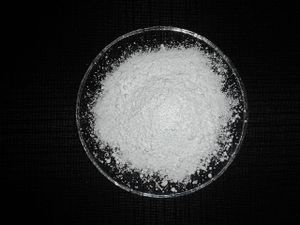Difference between revisions of "Sodium benzoate"
| Line 45: | Line 45: | ||
[[Category:Aromatic compounds]] | [[Category:Aromatic compounds]] | ||
[[Category:Readily available chemicals]] | [[Category:Readily available chemicals]] | ||
| + | [[Category:Materials available as food grade]] | ||
| + | [[Category:Edible chemicals]] | ||
Revision as of 12:13, 17 August 2015
Sodium benzoate is an organic chemical compound, used as a food preservative.
Contents
Properties
Chemical
Sodium benzoate will react with sodium hydroxide to produce benzene:
- C6H5OONa + NaOH → C6H6 + Na2CO3
Ascorbic acid will also reduce the salt to benzene.
Physical
Sodium benzoate is a white hygroscopic compound, with a characteristic smell. It has a solubility in water of 62.7 g/100 mL at standard conditions. Sodium benzoate is also soluble in liquid ammonia and pyridine. It is poorly soluble in methanol and ethanol.
Availability
Sodium benzoate is available as a food preservative, sold in sealed bags.
Preparation
Sodium benzoate can be prepared by reacting benzoic acid and sodium hydroxide, bicarbonate or carbonate.
Projects
- Benzene synthesis
- Whistle mix
Handling
Safety
Sodium benzoate has low toxicity to humans, and recent studies have shown to have some beneficial effects, in preventing Alzheimer and Parkinson's, though the results aren't conclusive so far. Cats however, have a significantly lower tolerance against benzoic acid and its salts, than rats and mice.
Storage
Should be stored in closed bottles, as it's slightly hygroscopic.
Disposal
Sodium benzoate has low toxicity and doesn't require special disposal.
